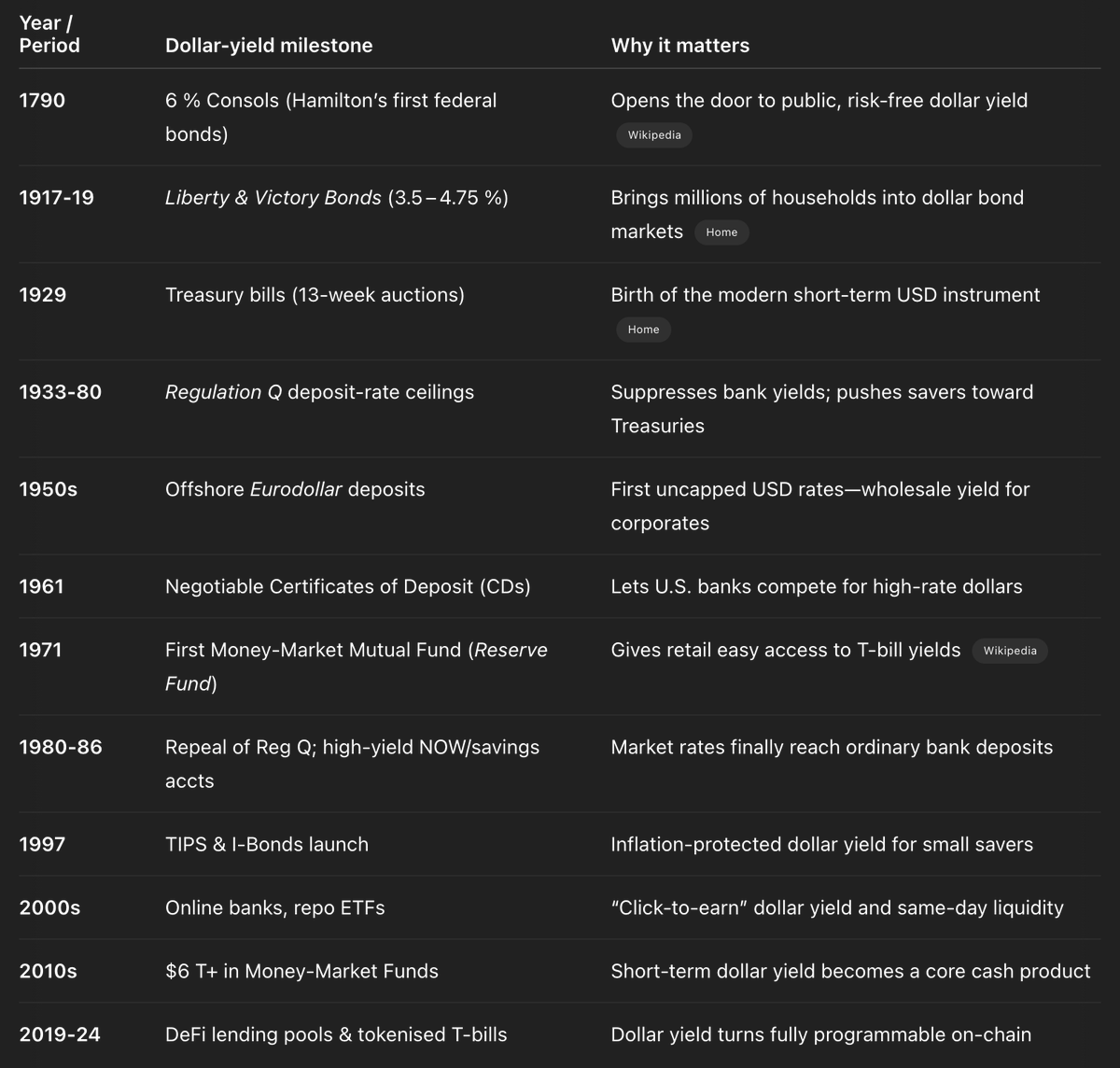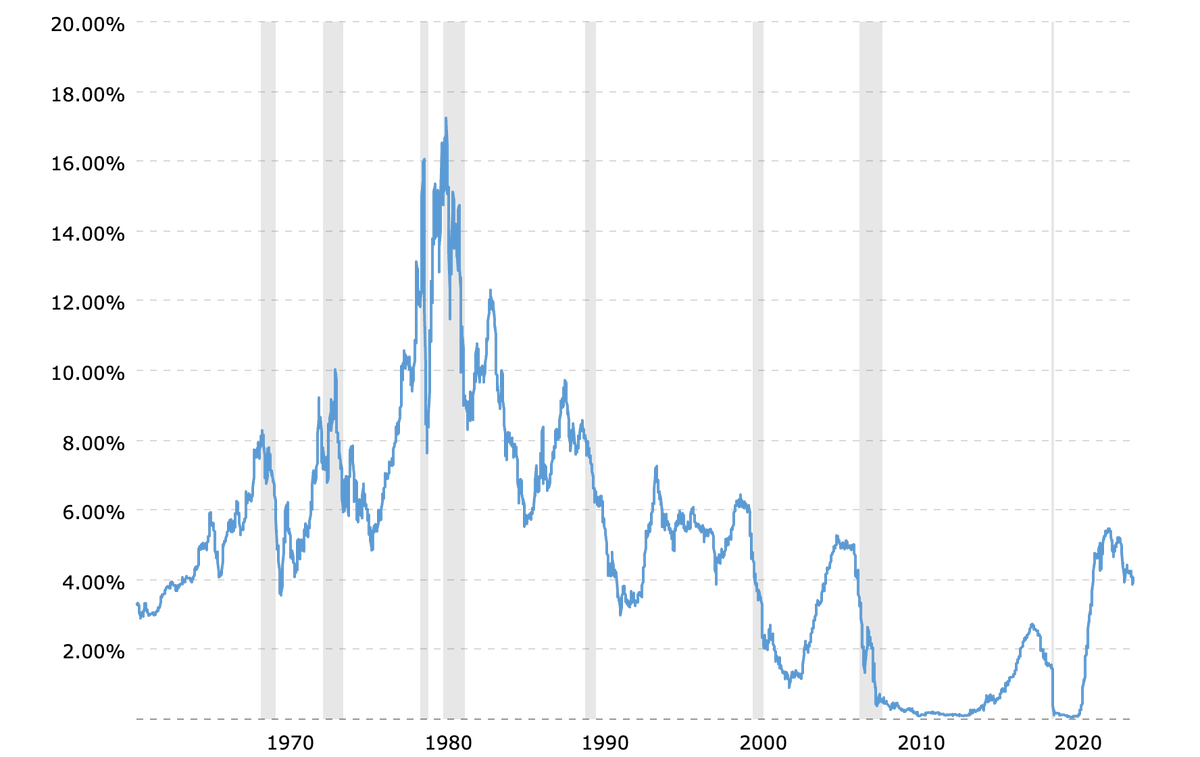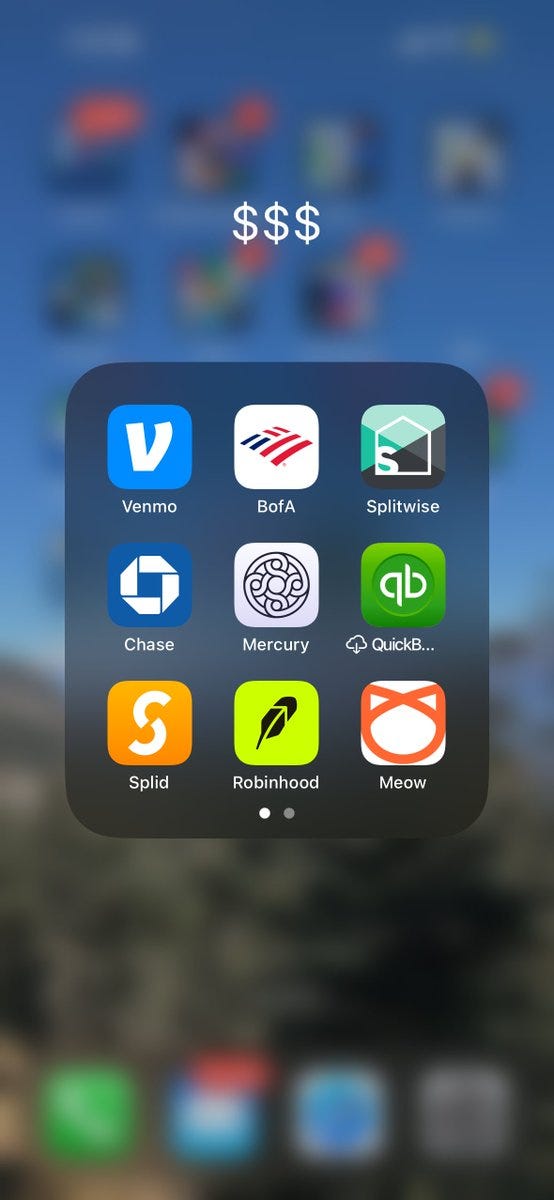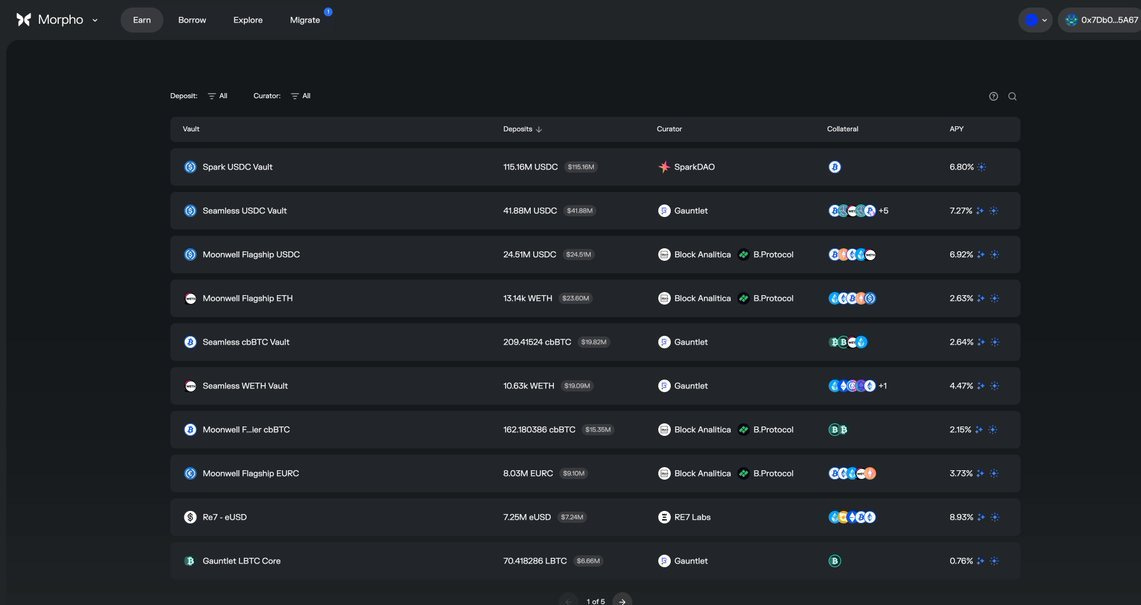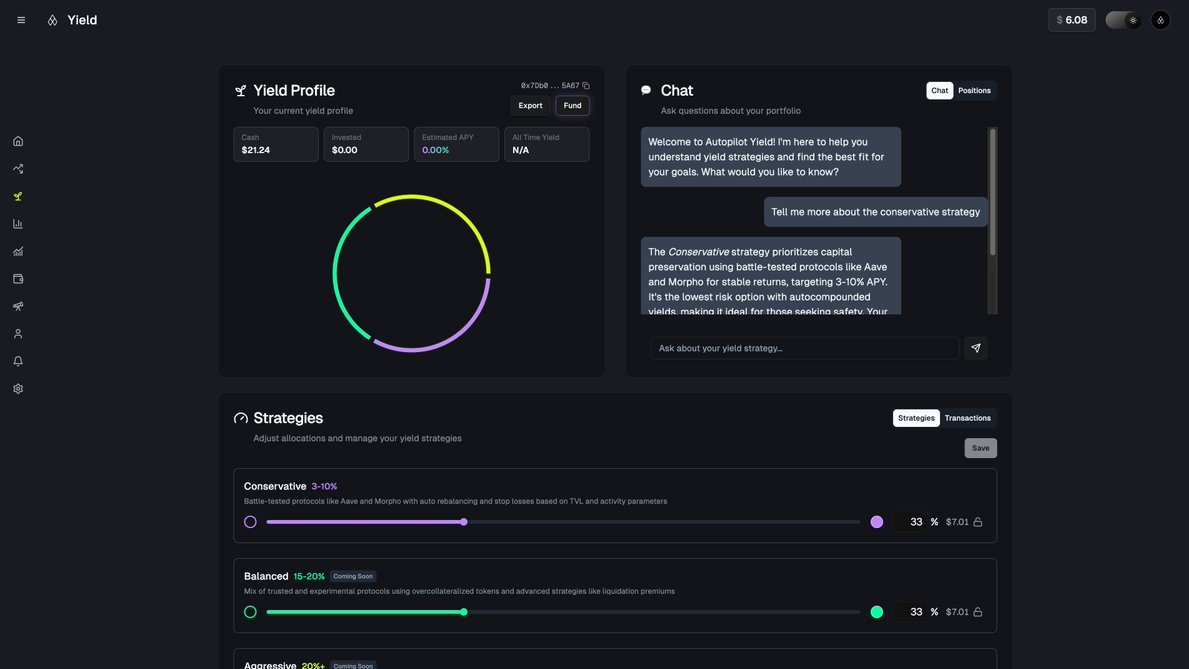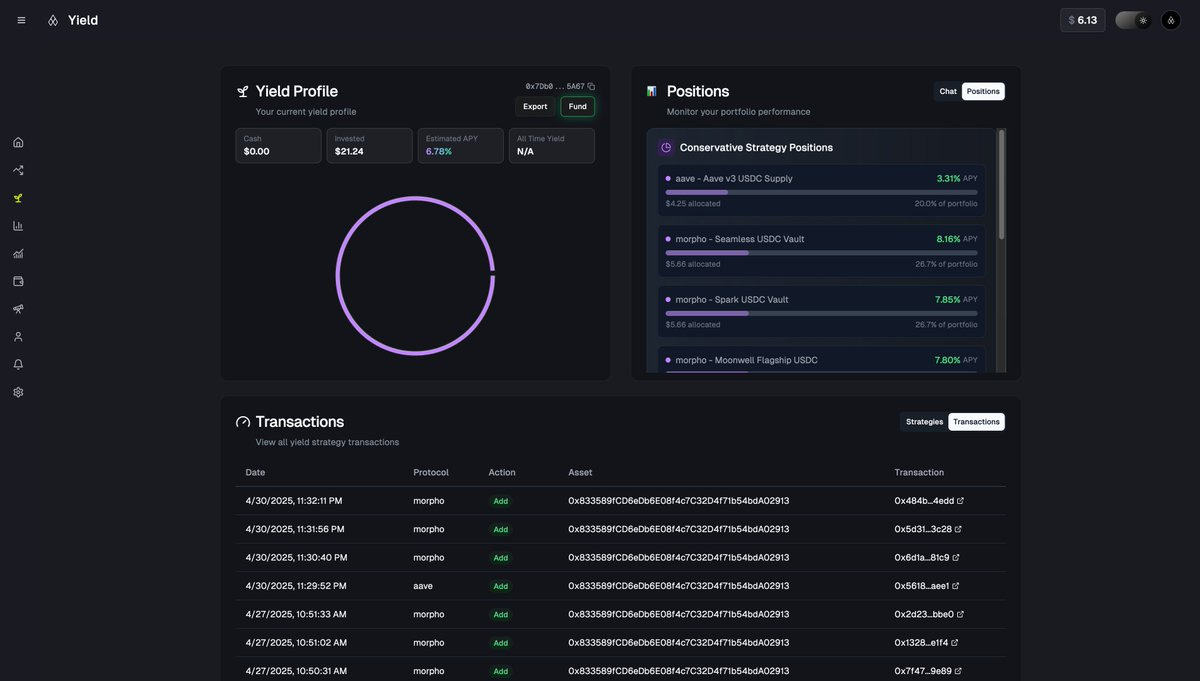The U.S. dollar remains the world's de facto currency -nearly 60% of foreign reserves and trade invoices are dollar-based. Stablecoins - with a $238B+ market cap, favorable policy from Washington, and support for settlement via major web2 payment merchants like Mastercard and Visa in just the past week - are poised to further expand access and usage of the dollar.
Beyond the dollar's role as a medium of exchange and unit of account, it is a store of value (in cash, digital bank accounts, and now onchain addresses) capable of earning yield.
From financing the American Revolution to being the bedrock of modern portfolios, the ways we "earn on the dollar" have changed tremendously.
This article explores the evolution of yield and what the next era of yield generation will look like. Stablecoins, novel DeFi primitives, and automation via personalized, verifiable agents will bring an endless stream of yield opportunities to all.
A History of Dollar-Based Yield
ChatGPT table summarizing the history of yield opportunities for the dollar
Earning "yield" on the dollar - income generated from putting dollars to work - has been practiced since America's inception. And while we think today's yield opportunities (particularly those in crypto) can get insane, yield has always had a crazy history.
Some particularly interesting examples:
Dutch loans + loans from France and Spain financed much of the American Revolution. American revolutionaries pretended that some loans were actually gifts, pissing off France and contributing to some future conflict. Future payments were quite messy post-war, with the U.S. defaulting, a calculated choice to pay back the Dutch before other countries because they were the most likely to provide future loans to America (correct bet), and a "haircut" on 6% domestic loans to ~4% (because Hamilton realized 6% was "too high" to pay).
Liberty Loans, used to finance WWI, worked because Americans reduced consumption by ~10% to finance bonds paying 3-5%. This was driven by one of history's largest advertising campaigns, with celebrities doing bond shows,
pilots doing stunts above towns where people had never seen an airplane, and the government hiring Freud's nephew to devise advertisements rooted in mass psychology ("My daddy bought a bond. Did yours?"). Even here, the government defaulted by refusing promised gold payouts on the 4th Liberty Bond, making their value decline by 41% of the principal.
Regulation Q (v1 in the 1930s until 2011) prevented banks from paying interest on checking accounts (demand deposits). Resulted in the rise of Eurodollars, money market funds, and alternative investment strategies.
Eurodollars, or dollars held outside of U.S. bank accounts, were all the rage in the second half of the 20th century. They were attractive because they allowed for dollar access without cumbersome regulation, and offered higher rates. The Soviet Union, a major holder of Eurodollars, ran a pretty complex trade in the 1950s using Italian banks to get higher interest rates by circumventing U.S. banking caps via Regulation Q.
Recurring themes are government defaults and a lack of guarantees for everyone involved.
The State of Web2/TradFi Yield
1 year treasury rates over the last 60+ years (https://www.macrotrends.net/2492/1-year-treasury-rate-yield-chart) - surprisingly volatile!
We'll divide yield today into a few broad categories - government securities, corporate securities, MMFs, CDs, and high-yield savings accounts.
Government Securities - Treasury bills (currently ~4%), bonds, and notes are all sold by the government to finance government operations.
Money Market Funds (MMFs) - actively managed mutual funds (fund pooling and investing money from many investors) that invest in cash/cash equivalents and liquid short-term securities. Governed strictly (Rule 2A-7 from 1940) and yield similar to government securities (~4%).
Corporate Bonds - companies in need of financing operations can offer loans, with varying levels of risk/interest rates depending on the creditworthiness of the company. Can range from AAA "safe" bonds to high yield "junk" bonds for risky companies. Moody's AAA corporate bond rate is currently ~5.5%.
CDs (Certificate of Deposit) - a type of savings account with fixed commitment/lock-up periods during which investors cannot withdraw, resulting in higher rates (~4.4%).
High-Yield Savings Accounts (HYSAs) - similar to CDs but without the lock-ups (~4% currently), taking a spread on profits from loans/other investments. Apps like Robinhood also offer similar rates for deposits (4% with Robinhood Gold).
These yield sources are accessed via the government directly (Treasury Direct), banks (Chase, BofA, etc.), banking services (Vanguard, Fidelity), and increasingly external fintech companies that combine and remix yield opportunities (PayPal, Robinhood, Wealthfront, Betterment, Meow, Mercury).
My personal finance/banking/yield stack (entirely mobile-based)
For most individuals, interactions with these yield sources are confined to a bank account and a few fintech apps on their phone; most don't have funds directly in government securities, MMFs or corporate bonds, and many don't have CDs or HYSAs.
Of course, there are many other investments/asset classes out there (less popular ones like commercial paper and municipal bonds, riskier ones like venture, private equity, hedge funds, real estate, etc.). The above are generally more risk-averse (dollar-based, government backed/insured in some capacity) and potentially less liquid.
Overall, there exist a fairly limited set of options to earn yield in traditional finance/web2 rails, with nearly all rates heavily correlated to federal interest rates/government securities. Heavy regulation gives stronger guarantees than centuries ago, but a few institutions dominate usage and determine yield.
The State of Web3/DeFi Yield
Below is a (non-exhaustive) list of some popular ways to generate yield, notable platforms, and challenges:
Lending - Aave, Compound, Morpho, Euler, Solend, Kamino and more protocols operate by having borrowers lock up collateral (greater than loan amount), programmatically stream interest payments to lenders (no credit score needed), and check utilization and liquidation thresholds (all done onchain). Users can also earn yield by fulfilling liquidations in exchange for earning collateral. While down from a peak of ~$64B in Q4 2024,onchain DeFi lending has ~$37B of assets across Ethereum mainnet, L2s, and Solana (~$2B). Rates vary tremendously depending on the asset, protocol, TVL in pools, LTV (loan-to-value) ratios, and utilization rate. As of writing, rates for USDC in major lending markets on Aave and Morpho are between 3-6%, ETH is 2-4%, and cbBTC is 0-2% (higher rates for Morpho vault strategies with lower TVL). Challenges include monitoring these stats, cashing out/looping reward tokens, and automating custom strategies across protocols.
Liquidity Provisioning (LPs) - Providing liquidity to DEXs like Uniswap and DEX-adjacent protocols like Kamino offers users trading fees, which can vary significantly by pool size and underlying assets. Generally, rates for dominant stablecoin-only pools are quite low (~0-1% base APR, sometimes subsidized like
this Unichain USDC/USDT pool at ~10% APR). Challenges include managing LP positions based on underlying asset prices, avoiding impermanent loss, setting optimal price ranges to provide liquidity, and timely redemptions of accrued fees.
Collateralized Debt Position (CDPs) - Popularized by Maker (now Sky) and being used by Reservoir Protocol and Felix Protocol, collateral is locked in a contract and backs a stablecoin. Yield is earned from collateral generating cashflows, yield on the stablecoin, and rewards for token holders. For Sky, the rewards rate and savings rate on USDS (the stablecoin) is ~5%. Challenges include ensuring collateral health and managing yield strategies.
Basis Trading - Protocols like Ethena (currently ~5% APY),Resolv and funds like
Superstate have delta-neutral/hedging derivative strategies on dominant crypto assets (BTC, ETH, SOL) to earn yield for holders of a corresponding stablecoin built on the strategy. Challenges include risk of the underlying strategy itself, depegging, manually staking/unstaking, and cashing out of rewards.
Points/Incentives Farming - Far less straightforward compared to other strategies, this involves moving funds between protocols to earn points, incentives, airdrops, token allocation, etc. Notable examples include Hyperliquid's (well-received) points program or Arbitrum's airdrop. Returns vary significantly, and are usually correlated with "useful" activity done on a protocol. Challenges include the logistics of using the new protocol/testnet version (bridging/swapping to it) and being active frequently enough to earn worthwhile rewards.
Real World Assets (RWAs) - An emerging source of yield has been from real world assets, where tokenized versions of popular web2/TradFi instruments (bonds, treasuries, private credit, etc.) have now surpassed $21.61B in size. Stablecoins via Ondo, Mountain Protocol, and others earn T-bill rates for holders. Platforms like Securitize tokenize TradFi funds (notably BlackRock's BUIDL, Apollo, and some venture funds). Rates vary by asset class, and notable challenges include proper offchain data feeds via oracles, liquid markets for onchain trading, and regulatory approval.
Staking - While not directly applicable to stablecoins, staking assets like ETH, SOL or BTC earn fees in exchange for securing blockchain networks. Popular platforms include Lido, Jito, and Rocket Pool for liquid staking (delegating assets to validators) and etherfi for restaking (using already staked tokens to secure additional networks). Rates are ~3% for ETH and ~8% for SOL. Challenges include monitoring underlying asset price and staking yields and validator risk.
Some more complex products aggregate yield strategies (Beefy Finance/Yearn/Hyperliquid vaults), support trading tokenized yield (Pendle), or leverage/loop strategies (Kamino Multiply, Contango). Centralized platforms like Coinbase are also offering boosted APYs on deposits to attract individuals, while also launching their own Bitcoin fund for institutional investors (opaque strategies, targeting 4-8%). CeFi lending via prime brokerages, OTC, and private credit is also a sizable source of yield.
For consumers, more intuitive products are popping up that use these primitives under the hood. Notable ones include directly via wallet interfaces, mobile apps like Lemon, and neobanks like Nubank (4% APY on USDC).
The Morpho Dashboard for yield opportunities on Base.
Navigating and managing web3 yield is a nightmare. Monitoring risk, discovering strategies, and simply moving funds between all the different protocols, chains and assets involved (even specialized yield tokens) is painful even for the most crypto-native users (who are the majority of users today). Nothing is easily customizable, automated, or powerful.
Gone are the web2/TradFi days of a few dominant assets and platforms (treasury bills via the U.S. federal government). Web3/DeFi yield has the potential to explode the number of possible ways to earn with interesting primitives, but we are a long way from truly global, autonomous yield.
What Global, Autonomous Yield Looks Like
A better yield solution that solves shortcomings in both TradFi and DeFi needs:
Automated - No matter your risk profile, managing a yield strategy is tedious. At best, you manage all of this manually, using external or internal tools, tracking rates and protocol health, etc. At worst (and for most people), you "miss out" on key events that change risk and fail to adapt in time. Automation solves all of this, but thus far has been limited and rigid (not tailored at all to user preferences).
Accessible + Informative UX - Knowing where yield is coming from and how it is earned is essential for all users. For both DeFi and TradFi yield, UX is generally bad - we absolve ourselves of knowledge to blackbox third parties and fine print with zero flexibility (bank accounts, funds, Robinhood earning through a mix of lending, bonds, and bills; sketchy complex DeFi vault websites with limited details on underlying strategies). Tokenization of assets and onchain verification of strategies, combined with streamlined "one-click" flows that automate actions, solves UX and makes earning accessible to all (BlackRock agrees).
Diversified - No matter your risk tolerance, diversifying helps protect you from underlying asset risk, "primitive" risk (lending, government backed, protocol rewards, etc.), and protocol risk (small vs. large DeFi pools). While conservative web2/TradFi risks are limited to the government, getting further uncorrelated exposure from primitives like DeFi lending, even sticking to stablecoins (let alone BTC or other truly independent assets), improves portfolio health.
Verifiable + Transparent - From the U.S. government defaulting on interest payments (many cases mentioned above) to DeFi yield protocols going under (Terra Luna depegging or Celsius bank run), a lack of guarantees on strategies and where user funds are at any point in time erodes confidence and hurts users. Especially as strategies get more complex, transparency is left to the wayside.
Global, autonomous yield is catered to a user's risk profile, earning from diversified venues, managed autonomously and verifiably, and accessible from any channel of importance (mobile app, website, APIs, LLMs, blockchains directly).
Larry Fink's annual letter - tokenization of all assets democratizes yield.
Let's look at a few different user personas, exploring their current situation and what a "dream yield" solution would be:
Recent grad, limited savings, low salary, most income spent on rent/food/transport (me) - current savings/yield stack is a bank checking account (~0% APY), Robinhood and some other mobile apps handling a Roth IRA and stocks/ETFs/crypto (longer term investments or bets, not really yield). I know I should be putting my money in treasuries (at a bare minimum), but having liquid cash is a priority to fund expenses, so I keep everything in the checking account. I know crypto (DeFi lending markets and LP pools) have higher rates and I'm comfortable with their risks, so long as they remain competitive, liquid, and safe (pool TVL doesn't get too volatile, auto reward token cash outs, always in a pool with high APY, leave those that fall, etc.). When onboarding, DCA rules are set up so a portion of my paycheck goes into yield earning strategies each month.
Small business owner in a non-US/European country, operates a shop earning a few tens of thousands of dollars a year - keeps all earnings in cash, local currency doesn't have great yield opportunities and is pretty volatile relative to the dollar, needs liquid access. A mobile-first app (or direct bank integration) with easy ramping to get USD stablecoins, a chat interface to understand strategies and setup automations, and instant liquidity would help protect savings while maximizing passive yield. Huge step up from the status quo, earning a few thousand dollars more a year.
Crypto-savvy investors - in the trenches with all the DeFi primitives mentioned above, burned a few times due to protocols going under, crashing pool TVLs, or a lack of diversification. Most stablecoins are sitting idle before making spot or perpetual trades. A one-click interface for parking these stablecoins into a conservative yield strategy earning 5-10% APY, along with a one-click "get out in seconds" button, would help them earn on idle assets without additional risk.
Registered Investment Advisors (RIAs) - today, getting exposure to digital assets for LPs is isolated to spot exposure, ETFs, or liquid/private venture; yield has not really been tapped. Offering a stablecoin yield product catered to specific client needs and strategies and uncorrelated from treasuries/alternative asset yield sources would help diversify while tapping into web3 opportunities. An intuitive dashboard with automations would protect clients from manual oversight and get exposure to intelligent strategies.
Large organization managing a variety of assets, payroll and business expenses across different currencies around the world. Companies like SpaceX
to mitigate FX risk, and could be earning yield on their balance sheet assets by parking them in RWAs earning from treasuries (extremely risk averse, but free money on the table while these stablecoins aren't bridged to fiat).
Axal's v1 - Autopilot Yield
Axal(@getaxal) is building a product providing global, autonomous yield for all, adaptive over time. Our initial yield product is live at yield.getaxal.com and inside our broader trading product (Autopilot), offering exposure to three strategy types varying in risk and rate. Pilot users earned higher, healthier yield than anything else available in TradFi or DeFi.
We believe that non-custodial smart wallets with permissions for what agents can do on your behalf, intents for yield constraint expression, integrations across DeFi (protocols and strategies mentioned above), strategy execution proofs and permissions (ZK, Permit2, and more), can offer ideal yield solutions for everyone.
Learning about strategies, modifying them, and getting out of them just requires speaking with an LLM assistant, dragging some sliders, or clicking a button. Strategies are managed by a non-custodial wallet owned by you, all transactions and positions are visible, and agents compete to provably find the best opportunities that fit your needs. Getting in and out of the app is as easy as signing in with Google and connecting a bank account to on-ramp/off-ramp.
Dashboard of yield exposure across categories and a chat assistant to learn more.
The current simple conservative strategy, a mix of 20% of funds in Aave and 80% across three major USDC Morpho pools, earns between 5-10% APY with strong risk diversification.
It takes under a minute to setup, with future plans to integrate ramps and speed things up even more.
Right now, the 7% rate is better than Robinhood, HYSAs, or DeFi protocols that lack risk management automations and diversification.
Our goal is to make this the best place to earn on the dollar, for everyone.
A 100% conservative strategy (currently earning ~7% across Aave and Morpho pools) and an audit trail of transactions.
The history of yield opportunities has been brutal - counterparty risk is high, UX is terrible, and opportunities are hard to manage.
Global, autonomous yield - powered by stablecoins, new DeFi primitives, and verifiable agents - will bring significant earning opportunities to all and create efficient, democratic yield markets.
A world where anyone can type into diverse yield strategies across different assets, automate yield management decisions, and earn a little bit more on their assets (low risk/their risk tolerance level) is net good for humanity.
Follow @getaxal for more content, DM if you are interested in exploring the future of agents and yield with us, and try our product out in less than a minute at yield.getaxal.com.





